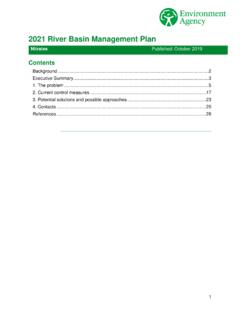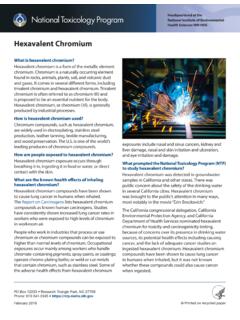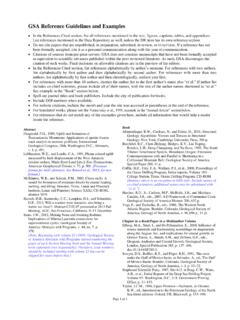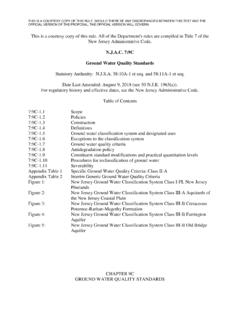Transcription of Perfluorooctane sulfonate (PFOS) and related substances ...
1 Perfluorooctane sulfonate (PFOS) and related substances : sources, pathways and environmental data October 2019 We are the Environment Agency. We protect and improve the environment. We help people and wildlife adapt to climate change and reduce its impacts, including flooding, drought, sea level rise and coastal erosion. We improve the quality of our water, land and air by tackling pollution. We work with businesses to help them comply with environmental regulations. A healthy and diverse environment enhances people's lives and contributes to economic growth.
2 We can t do this alone. We work as part of the Defra group (Department for Environment, Food & Rural Affairs), with the rest of government, local councils, businesses, civil society groups and local communities to create a better place for people and wildlife. Published by: Environment Agency Horizon House, Deanery Road, Bristol BS1 5AH Environment Agency 2019 All rights reserved. This document may be reproduced with prior permission of the Environment Agency. Environment Agency copyright and / or database right 2009.
3 All rights reserved. Maps included in this document contain data supplied under licence from: Crown Copyright and database right 2009. All rights reserved. Ordnance Survey licence number 100026380 Further copies of this report are available from our publications catalogue: or our National Customer Contact Centre: 03708 506 506 Email: 2 of 44 Executive summary Perfluorooctane sulfonate (PFOS) belongs to a large, diverse group of man-made substances known collectively as perfluoroalkyl and polyfluoroalkyl substances (PFASs).
4 substances in this group are known for their water, grease and stain repellent properties. Over the past 50 years, perfluoroalkylated substances such as PFOS and PFOS related substances have been used in a diverse range of domestic consumer products, as well as in industrial processes and in aqueous film forming foams (AFFFs) used in fire-fighting. PFOS is extremely persistent, toxic and bioaccumulates through the food chain. Most uses of PFOS have now been phased out, banned or restricted under a number of UK, EU and international regulations.
5 PFOS was listed as a persistent organic pollutant (POP) in Annex B (restriction) of the UNEP Stockholm Convention on POPs in 2009. In the Priority substances Directive (2013/39/EU), PFOS is classed as a Water Framework Directive priority hazardous substance and as a ubiquitous persistent, bioaccumulative and toxic substance. Despite the restrictions on use, older consumer products such as carpets, textiles and upholstery that have been treated with PFOS or PFOS- related substances will continue to act as a source of PFOS.
6 Emissions can occur during the use, washing and disposal of such items, entering the environment via waste water treatment works or waste management facilities. Evidence in the scientific literature suggests the limited removal of PFOS is likely to occur via adsorption to sludge. Academic studies suggest that PFOS may also be formed during waste water treatment as a result the transformation of other PFOS related substances . Additional, potentially significant sources of PFOS to the environment include landfill sites, industrial discharges and local historical contamination especially around sites such as military bases and airports where there may have been significant use of AFFFs during fire-fighting training.
7 PFOS can be present in soil from such historical sources or from the spreading of sewage sludge to land. Because PFOS is very water soluble and consequently very mobile, it can enter surface waters from contaminated soil as well as leach to groundwater . PFOS is a widespread environmental contaminant. Our monitoring programme in surface waters has reported the presence of PFOS in all fish sampled from fresh, estuarine and coastal waters. Measured concentrations in fish ranged from below the environmental quality standard (EQS) to up to 4 times greater than the biota EQS.
8 The biota EQS for PFOS was set to protect both wildlife and people and is based on human health endpoints as these are the most sensitive. There are currently no regulatory limits for this substance in food, including fish, although this situation will be reviewed on the basis of new European Food Safety Authority opinions. Monitoring of biota presents a number of challenges that are not encountered when we sample water including animal welfare concerns and practical considerations driven by the availability of suitable animals, accessibility and ecological impact of sampling.
9 Consequently the extent of our biota surveillance programme is much smaller than our water monitoring network. PFOS is frequently detected in surface waters across England. Concentrations of PFOS in water vary, but are typically reported at levels above a freshwater annual average (AA) EQS, a value that has been calculated from the biota EQS. 3 of 44 Analysis of our water and biota data from the same freshwater locations over several years suggests that using the water EQS to assess exceedance of the biota EQS may over predict the likely failure of the biota standard.
10 Analysis of measured concentrations of PFOS in freshwater and fish in the same locations suggest a correlation. We have used this to estimate the level in water above which we can infer failure of the biota EQS with reasonable confidence. This provides the possibility of using water data to inform a national model of PFOS risk, drawing on relatively plentiful water sampling locations to supplement the limited coverage offered by biota sampling alone. PFOS is one of the most frequently detected compounds in our groundwater monitoring programme, with 30% of sites sampled having positive detections (Lapworth et al, 2018).





